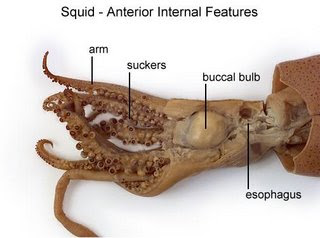





Circulatory system
Squid have three hearts. Two branchial hearts, feeding the gills, each surrounding the larger systemic heart that pumps blood around the body. The hearts have a faint greenish appearance and are surrounded by the renal sacs - the main excretory system of the squid. The kidneys are faint and difficult to identify and stretch from the hearts (located at the posterior side of the ink sac) to the liver. The systemic heart is made of three chambers, a lower ventricle and two upper auricles.
Nervous system
The squid has the most complicated brain of all the invertebrates. The squids brain is estimated to have 300,000,000 neurons. These neurons are arranged in lobes and tracts that are more specialized than simple ganglia. An squid has a "good" memory and can also learn. The eye of the squid is very similar to that of vertebrates in that it has a cornea, lens, iris and retina. It can also focus and form images. However, the squid eye is different from that of vertebrates in that it focuses light by moving the lens closer and further away from the retina. The vertebrate eye focuses by changing the shape of the lens.squid can perceive shape, color intensity and texture. Another difference is that the eye of the squid has NO blind spot because the nerve cells leave from the outside of the eyeball. The squid also has a statocyst located next to the brain. The statocyst is used to detect changes in gravity and respond to acceleration.
Integumentary
The Male body was generated from scans of a live model. With optimized geometric resolution for detailed renderings, and a high level of anatomical accuracy representing an ideal physique. The Integumentary system currently comes with 2 models: Male skin w/ and w/o genitalia.
Excretory system
The kidneys remove wastes form the blood and maintain the body’s water balance, which are the primary oragans of the excretory system. Squid have an excretory organ to expel wastes fro the body .
Reproductive system
In female squid, the ink sac is hidden from view by a pair of white nidamental glands, which lie anterior to the gills. There are also red-spotted accessory nidamental glands. Both of these organs are associated with manufacture of food supplies and shells for the eggs. Females also have a large translucent ovary, situated towards the posterior of the visceral mass.Male squid do not possess these organs, but instead have a large testis in place of the ovary, and a spermatophoric gland and sac. In mature males, this sac may contain spermatophores, which are placed inside the mantle of the female during mating.
Body Plan
Squid has highly complex brains that rival the complexity of vertebrates. All of these species are highly active, agile predators. They possess a beak-like mouth that is used to rip apart captured prey items.
Digestive System
Squid, like all cephalopods, have complex digestive systems. Food is transported into a muscular stomach , found roughly in the midpoint of the visceral mass. The bolus is then transported into the caaecum for digestion. The caecum, a long, white organ, is found next to the ovary or testis. In mature squid, more priority is given to reproduction and so the stomach and caecum often shrivel up during the later stages of life. Finally, food goes to the liver (or digestive gland), found at the siphon end of the squid, for absorption. Solid waste is passed out of the rectum . Beside the rectum is the ink sac, which allows a squid to discharge a black ink into the mantle cavity at short notice.
Habit
Squid inhabit naturally occurring dens on the ocean floor which are in crevices and under rocks for several weeks before they will find a new one. They are nocturnal, solitary creatures that hunt for several hours at night collecting food that is brought back to the den and devoured.
Diet
Adult diet includes mostly crustaceans, mollusks, and fish including small crabs, bivalves, snails and other squids). When eating shelled prey they may use arms to pull it apart, bite it with its beak or use the radula to actually drill through the shell. The mouth is able to secrete enzymes that soften the shell and toxins to paralyze prey and dissolve tissue
Distinguishes as molluscs
Squid have differentiated from their ancestral mollusks in such a way that the body plan has been condensed antero-posteriorly and extended dorso-ventrally. What before may have been the foot of the ancestor is now modified into a complex set of tentacles and highly developed sense organs, including advanced eyes similar to those of vertebrates.
The pictures are found in:
- http://images.google.com/images
- http://sps.k12.ar.us/massengale/squid_dissection.htm


No comments:
Post a Comment